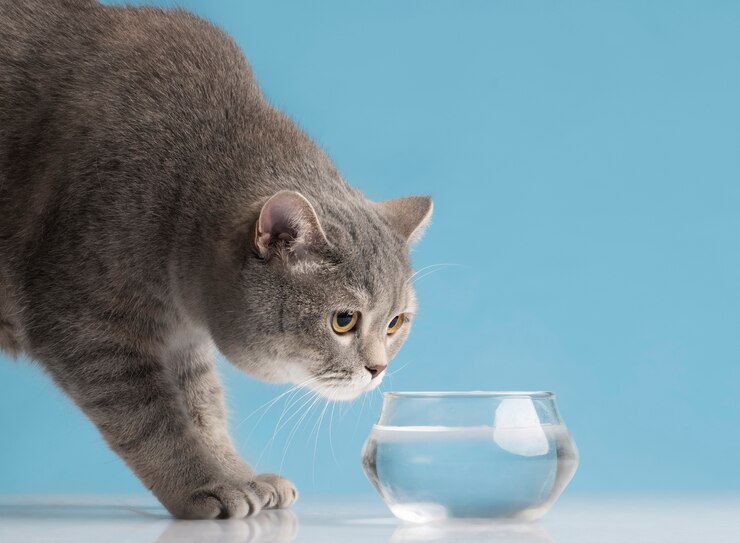Water is essential to keep cats healthy and hydrated, but if your cat isn’t drinking enough, it could be due to various factors, including health concerns, environment, and preferences. Here, we’ll explore the primary reasons and solutions, with expert insights to guide you.
Why Is My Cat Not Drinking Water
Those Medical Issues That Could Be Behind This
Sometimes, not drinking water can be a sign that something’s up with your cat’s health. Kidney disease is a big one – it’s pretty common in older cats and can make them either drink way more or way less water than usual. Diabetes is another condition that usually makes cats super thirsty, so if your usually thirsty cat suddenly stops drinking, it could be a red flag.
Dental problems can also make drinking painful. Just imagine trying to drink with a toothache – not fun, right? Some cats might have sore gums, broken teeth, or other mouth issues that make them reluctant to drink. Even something as simple as a cold or upper respiratory infection can make drinking uncomfortable.
Environmental Preferences
Cats have distinct preferences when it comes to their water setup, and understanding these can make a huge difference in their drinking habits. Most cats are incredibly particular about where their water bowls are placed and absolutely hate having them near their food or litter boxes – it’s just part of their natural instincts for cleanliness. Read How to Train Your Cat to Use the Litter Box
Purina’s research shows that simply placing multiple water bowls around your house, especially in quiet corners, can significantly increase your cat’s water intake. When it comes to bowl materials, plastic is often a poor choice because it tends to hold onto odors and can even give the water a funny taste. Instead, ceramic or stainless steel bowls are much better options, being both easier to clean and less likely to affect the water’s taste.
Potential Hidden Water Sources
Your cat might be getting more water than you realize through various sources you haven’t considered. One major source is wet food, which can contain up to 80% moisture – Chewy’s experts point out that cats eating primarily wet food naturally need less additional water since they’re getting so much from their food. Many cats also have a fascinating attraction to running water, which explains why you might find them trying to drink from faucets or showing interest in moving water sources. Read Why Do Cats Kick Litter Everywhere?
Dr. Karen Becker, a well-known veterinarian, strongly advocates for pet water fountains as an excellent solution, since the moving water appeals to cats’ natural instincts and often appears fresher and more appealing to them than still water in a bowl.
Behavioral and Stress-Related Factors
A cat’s drinking habits can be significantly affected by changes in their environment or daily routine. When cats experience stress or anxiety from things like moving to a new home, adjusting to a new pet, or dealing with changes in their regular routine, they might drink less water. Dr. Marci Koski, an experienced feline behaviorist, suggests creating calm, quiet spaces for water bowls and using pheromone sprays nearby to help reduce stress levels.
Sometimes, the issue isn’t stress at all but simple boredom – cats can get tired of the same old water setup. Introducing variety through different types of bowls or adding a water fountain can help renew their interest in drinking and keep them properly hydrated.
Solutions for Increasing Water Intake
Your cat not drinking enough water can be worrying, but there’s usually a simple fix. Cats naturally drink less than dogs since they evolved from desert animals and get moisture from their food. However, if you notice dry gums, sticky saliva, or less urination, your cat might need more water.
Medical issues can cause drinking problems. Kidney disease affects older cats’ thirst levels, while dental problems can make drinking painful. Sometimes it’s just a cold or respiratory infection making things uncomfortable. But often, cats are just picky about their water setup. Read When Does a Cat Become an Adult?
Location really matters with cats. They hate having water near food or litter boxes – it’s an instinct from the wild where water near food could be contaminated. Try placing multiple water bowls around your house in quiet spots. The bowl material is important too – many cats dislike plastic because it leaves a taste, while others don’t like seeing their reflection in metal bowls.
Water temperature and freshness make a big difference. Most cats prefer cool, fresh water over room temperature or stale water. Try changing the water twice daily and using ceramic or glass bowls that don’t affect the taste. Many cats love running water, which is why they drink from faucets. A pet fountain could solve this – it keeps water moving and filtered.
Getting creative helps too. You can add ice cubes to make the water more interesting or mix extra water into their wet food. Some cats love “kitty popsicles” made from frozen low-sodium chicken broth. Increasing wet food in their diet naturally boosts water intake since it’s mostly water anyway.
How Much Water Should a Cat Drink?
Cats need adequate hydration to support their health, though their water needs can vary based on their diet and lifestyle. Generally, a healthy cat requires around 3.5 to 4.5 ounces (100-130 ml) of water per 5 pounds of body weight each day. For an average 10-pound cat, this translates to about 7-9 ounces (200-260 ml) daily, including all water sources like direct drinking, wet food, and even metabolic water.
Factors Influencing Water Intake
A cat’s diet plays a crucial role in determining how much additional water they need to stay healthy. When cats eat primarily dry food, which only contains about 10% moisture, they need to drink significantly more water to stay properly hydrated.
On the flip side, cats eating wet food get a big boost in their water intake since these foods contain 70-80% moisture. Environmental conditions also play a significant part in your cat’s water needs – cats living in warmer climates or those who are more active typically need more water to stay healthy. Health conditions can dramatically affect how much water your cat needs; conditions like kidney disease or diabetes can change their water requirements significantly. If you’re dealing with any health issues, it’s important to work with your vet to create a specific hydration plan for your cat.
How to Ensure Proper Hydration
Making sure your cat stays well-hydrated involves several key strategies. One of the most effective approaches is placing multiple water bowls throughout your house, making sure they’re always clean and located in quiet areas where your cat feels safe drinking. Many cats have a natural attraction to moving water, which makes pet fountains an excellent investment – they often encourage cats to drink more frequently. Read 5 Angry Cat Sounds To Understand In 2024
It’s also important to keep track of how much water your cat is drinking by measuring the water levels in their bowls daily. This monitoring helps you notice any concerning changes in their drinking habits early on.
Signs of Dehydration in Cats
Knowing the signs of dehydration in cats is crucial for catching problems early. Watch out for obvious physical signs like sunken eyes, dry gums, and reduced skin elasticity – if you gently pinch your cat’s skin and it doesn’t quickly return to its normal position, this could indicate dehydration. Other warning signs include lethargy and noticeably darker urine. It’s especially important to stay vigilant about these signs if your cat mainly eats dry food, as they’ll need to make up for the lack of moisture through drinking.
When It’s Time to Call the Vet
While there are lots of simple reasons why your cat might not be drinking enough water, sometimes it can be a sign of something more serious. If your cat goes more than 24 hours without drinking, or if they’re showing other concerning symptoms like lethargy, vomiting, or changes in urination, it’s definitely time to see the vet.
Your vet can check for underlying health issues and make sure your cat isn’t dehydrated.
Read Further



